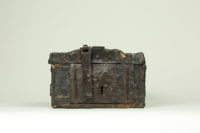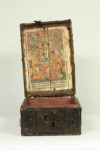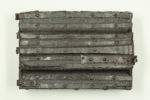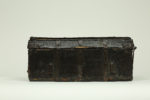 The University of Oxford’s Bodleian Libraries has acquired a rare late 15th century book chest. The Bodleian’s collection of manuscripts and early printed books is one of the largest in the world, but this is its first book coffer and it’s a special one. At 8.5 x 12.6 x 5.5 inches in size, it is one of the largest examples of a book coffer from this period known to survive.
The University of Oxford’s Bodleian Libraries has acquired a rare late 15th century book chest. The Bodleian’s collection of manuscripts and early printed books is one of the largest in the world, but this is its first book coffer and it’s a special one. At 8.5 x 12.6 x 5.5 inches in size, it is one of the largest examples of a book coffer from this period known to survive.
This acquisition gives us greater insight into the ‘everyday life’ of books and print culture more broadly. The coffer provides a link between books held at the Bodleian and cultural objects which were once united, but now usually live apart in libraries and museums around the world.
Dr Christopher Fletcher, Keeper of Special Collections at the Bodleian Libraries, said:
“The Bodleian collects books and manuscripts but also objects which helps us to understand the history and culture of the book – how they were kept, used, moved and understood. The coffer is a remarkable item which is both utilitarian and devotional and preserves an exceptionally rare woodcut in its original context. Among other things, it shows us that our preoccupation with carrying information around with us in mobile devices – including texts and images – is nothing new.”
The coffer is made of leather-covered wood and is lined with red canvas. The cover is wrapped with nine iron bands, hinges and a lock to secure the high-value contents. Also known as a messenger’s box, it has two iron loops on the side through which leather straps would have been threaded through so it could be carried on a person’s shoulders or attached to a horse’s saddle.
 A woodcut depicting God the Father in Majesty is affixed to the inside of the lid, one of only four surviving impressions of this print. His presence would have blessed the contents and protected them during their journeys. Other coffers from this time also contain religious prints on the inside lid, and it’s possible they served double duty as portable altars.
A woodcut depicting God the Father in Majesty is affixed to the inside of the lid, one of only four surviving impressions of this print. His presence would have blessed the contents and protected them during their journeys. Other coffers from this time also contain religious prints on the inside lid, and it’s possible they served double duty as portable altars.
It is a version of an illumination in a 1491 Missal by the Master of the Très Petites Heures of Anne of Brittany, a Paris illuminator who was active in the last quarter of the 15th century. He was a versatile artist who created designs for woodcuts, metalcuts, tapestries and stained glass as well as creating illuminated manuscripts for his highest-end clientele. The hand-colored prints found in messenger’s boxes were produced in Paris between 1490 and 1510, which is how we know where and when this coffer was made. These boxes are the only sources of single-leaf French prints before 1500. They are literally the only examples we have of the dawn of printmaking in France.
 We have confirmation that these types of lockboxes were used to transport precious books as well as other valuables because depictions of them being used for this purpose have survived, most notably a Rest on the Flight into Egypt made in Antwerp around 1530 which shows a partially open coffer by Mary’s side. At the back is a small book with metal clasps. In front of it are a rosary, a pair of scissors and a brush.
We have confirmation that these types of lockboxes were used to transport precious books as well as other valuables because depictions of them being used for this purpose have survived, most notably a Rest on the Flight into Egypt made in Antwerp around 1530 which shows a partially open coffer by Mary’s side. At the back is a small book with metal clasps. In front of it are a rosary, a pair of scissors and a brush.
The coffer has gone display at the Bodleian’s Weston Library in a new exhibition, Thinking Inside the Box: Carrying Books Across Cultures, which runs until February 17th. You can see 3D models of the box here.


